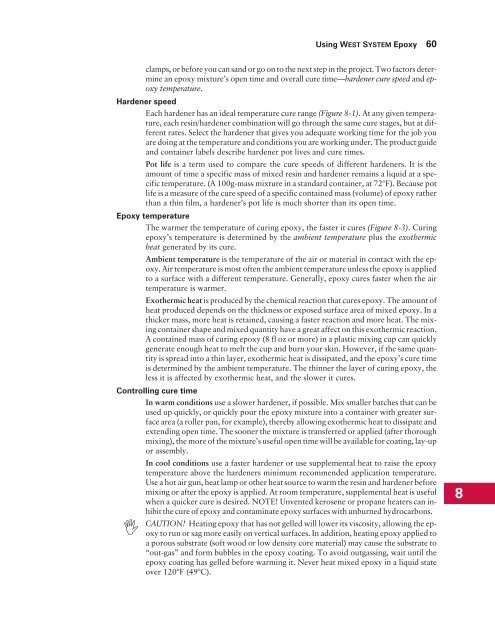Wooden Boat Restoration Repair - WEST SYSTEM Epoxy
Wooden Boat Restoration Repair - WEST SYSTEM Epoxy
Wooden Boat Restoration Repair - WEST SYSTEM Epoxy
Create successful ePaper yourself
Turn your PDF publications into a flip-book with our unique Google optimized e-Paper software.
Using <strong>WEST</strong> <strong>SYSTEM</strong> <strong>Epoxy</strong> 60<br />
clamps, or before you can sand or go on to the next step in the project. Two factors determine<br />
an epoxy mixture’s open time and overall cure time—hardener cure speed and epoxy<br />
temperature.<br />
Hardener speed<br />
Each hardener has an ideal temperature cure range (Figure 8-1). At any given temperature,<br />
each resin/hardener combination will go through the same cure stages, but at different<br />
rates. Select the hardener that gives you adequate working time for the job you<br />
are doing at the temperature and conditions you are working under. The product guide<br />
and container labels describe hardener pot lives and cure times.<br />
Pot life is a term used to compare the cure speeds of different hardeners. It is the<br />
amount of time a specific mass of mixed resin and hardener remains a liquid at a specific<br />
temperature. (A 100g-mass mixture in a standard container, at 72°F). Because pot<br />
life is a measure of the cure speed of a specific contained mass (volume) of epoxy rather<br />
than a thin film, a hardener’s pot life is much shorter than its open time.<br />
<strong>Epoxy</strong> temperature<br />
The warmer the temperature of curing epoxy, the faster it cures (Figure 8-3). Curing<br />
epoxy’s temperature is determined by the ambient temperature plus the exothermic<br />
heat generated by its cure.<br />
Ambient temperature is the temperature of the air or material in contact with the epoxy.<br />
Air temperature is most often the ambient temperature unless the epoxy is applied<br />
to a surface with a different temperature. Generally, epoxy cures faster when the air<br />
temperature is warmer.<br />
Exothermic heat is produced by the chemical reaction that cures epoxy. The amount of<br />
heat produced depends on the thickness or exposed surface area of mixed epoxy. In a<br />
thicker mass, more heat is retained, causing a faster reaction and more heat. The mixing<br />
container shape and mixed quantity have a great affect on this exothermic reaction.<br />
A contained mass of curing epoxy (8 fl oz or more) in a plastic mixing cup can quickly<br />
generate enough heat to melt the cup and burn your skin. However, if the same quantity<br />
is spread into a thin layer, exothermic heat is dissipated, and the epoxy’s cure time<br />
is determined by the ambient temperature. The thinner the layer of curing epoxy, the<br />
less it is affected by exothermic heat, and the slower it cures.<br />
Controlling cure time<br />
In warm conditions use a slower hardener, if possible. Mix smaller batches that can be<br />
used up quickly, or quickly pour the epoxy mixture into a container with greater surface<br />
area (a roller pan, for example), thereby allowing exothermic heat to dissipate and<br />
extending open time. The sooner the mixture is transferred or applied (after thorough<br />
mixing), the more of the mixture’s useful open time will be available for coating, lay-up<br />
or assembly.<br />
In cool conditions use a faster hardener or use supplemental heat to raise the epoxy<br />
temperature above the hardeners minimum recommended application temperature.<br />
Use a hot air gun, heat lamp or other heat source to warm the resin and hardener before<br />
mixing or after the epoxy is applied. At room temperature, supplemental heat is useful<br />
when a quicker cure is desired. NOTE! Unvented kerosene or propane heaters can inhibit<br />
the cure of epoxy and contaminate epoxy surfaces with unburned hydrocarbons.<br />
CAUTION! Heating epoxy that has not gelled will lower its viscosity, allowing the ep-<br />
<br />
oxy to run or sag more easily on vertical surfaces. In addition, heating epoxy applied to<br />
a porous substrate (soft wood or low density core material) may cause the substrate to<br />
“out-gas” and form bubbles in the epoxy coating. To avoid outgassing, wait until the<br />
epoxy coating has gelled before warming it. Never heat mixed epoxy in a liquid state<br />
over 120°F (49°C).<br />
8
















